
Fraxinus americana, the white ash or American ash, is a species of ash tree native to eastern and central North America. It is found in mesophytic hardwood forests from Nova Scotia west to Minnesota, south to northern Florida, and southwest to eastern Texas. Isolated populations have also been found in western Texas, Wyoming, and Colorado, and the species is reportedly naturalized in Hawaii.
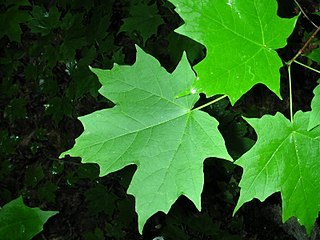
Acer saccharum, the sugar maple or rock maple, is a species of flowering plant in the soapberry and lychee family Sapindaceae. It is native to the hardwood forests of eastern Canada, from Nova Scotia west through southern Quebec, central and southern Ontario to southeastern Manitoba around Lake of the Woods, and northcentral and northeastern United States, from Minnesota eastward to Maine and southward to northern Virginia, Tennessee and Missouri. Sugar maple is best known for being the primary source of maple syrup and for its brightly colored fall foliage.

Cornus florida, the flowering dogwood, is a species of flowering tree in the family Cornaceae native to eastern North America and northern Mexico. An endemic population once spanned from southernmost coastal Maine south to northern Florida and west to the Mississippi River. The tree is commonly planted as an ornamental in residential and public areas because of its showy bracts and interesting bark structure.

The Crambidae are the grass moth family of lepidopterans. They are variable in appearance, the nominal subfamily Crambinae taking up closely folded postures on grass stems where they are inconspicuous, while other subfamilies include brightly coloured and patterned insects which rest in wing-spread attitudes.

Fraxinus pennsylvanica, the green ash or red ash, is a species of ash native to eastern and central North America, from Nova Scotia west to southeastern Alberta and eastern Colorado, south to northern Florida, and southwest to Oklahoma and eastern Texas. It has spread and become naturalized in much of the western United States and also in Europe from Spain to Russia.
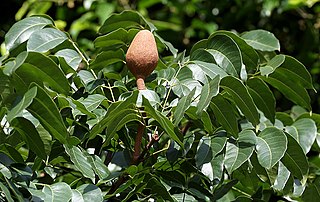
Swietenia is a genus of trees in the chinaberry family, Meliaceae. It occurs natively in the Neotropics, from southern Florida, the Caribbean, Mexico and Central America south to Bolivia. The genus is named for Dutch-Austrian physician Gerard van Swieten (1700-1772). The wood of Swietenia trees is known as mahogany.
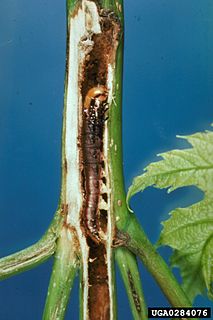
The stalk borer is a moth of the family Noctuidae. It is found from southern Canada, through the Eastern United States to the Gulf of Mexico, although it is absent from Florida.

Phragmataecia castaneae, the reed leopard or giant borer, is a moth of the family Cossidae. It was described by Jacob Hübner in 1790. It is found in central and southern Europe, the Middle East, the Caucasus, Transcaucasia, Turkmenistan, Kazakhstan, north-western Iran, Iraq, Syria, Sri Lanka, Madagascar, India, Lebanon, Turkey, western China, south-western Siberia, Egypt, Tunisia and Morocco.
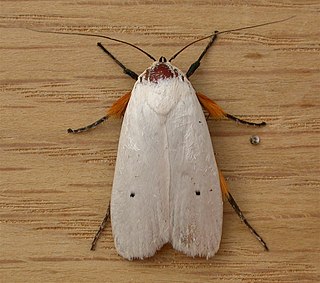
The fruit tree borer is a moth of the family Xyloryctidae. It is native to Australia.

Synanthedon acerni, the maple callus borer, is a moth of the family Sesiidae. It is found in Western Canada and much of the Eastern United States.

Hypena baltimoralis, the Baltimore bomolocha or Baltimore hypena, is a moth of the family Erebidae. The species was first described by Achille Guenée in 1854. It is found in the eastern part of the United States, west and south to Wisconsin, Missouri and Florida and Texas.
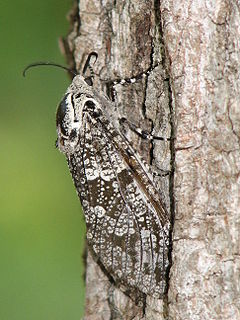
Prionoxystus robiniae, the carpenterworm moth or locust borer, is a moth of the family Cossidae. It was first described by Peck in 1818 and it is found in southern Canada and most of the United States.

Hypsipyla grandella is a moth of the family Pyralidae. It is found in southern Florida, most of the West Indies, Sinaloa and southward in Mexico, Central America, South America except Chile and in Mauritius.

Episimus is a genus of moths belonging to the subfamily Olethreutinae of the family Tortricidae.

Proteoteras aesculana, the maple twig borer, early proteoteras or maple tip moth, is a moth of the family Tortricidae. It is found from coast to coast in the northern United States, south to Mississippi in the east and to California in the west. It has a scattered distribution in Canada, from Nova Scotia to southern Alberta.
Carmenta anthracipennis, the liatris borer moth, is a moth of the family Sesiidae. It was described by Jean Baptiste Boisduval in 1875, and is known from the United States, including Florida, Texas, Massachusetts and Illinois.
Paraclemensia acerifoliella, the maple leafcutter moth, is a moth of the family Incurvariidae. It is found from south-eastern Canada and the north-eastern United States, south to the tip of the Appalachian Mountains in western North Carolina and possibly north-western Georgia.
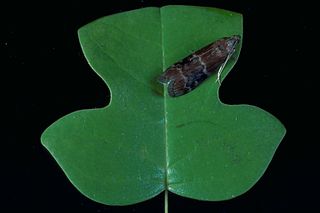
Euzophera ostricolorella, the root collar borer moth or tuliptree borer, is a species of moth of the family Pyralidae. It was described by George Duryea Hulst in 1890. The species is found in the United States from Arkansas and Louisiana to northern Florida, north to Michigan and New York.
Chilo infuscatellus, the yellow top borer or sugarcane shoot borer, is a moth in the family Crambidae. It was described by the Dutch entomologist Samuel Constantinus Snellen van Vollenhoven in 1890. It is found in India, Myanmar, Tajikistan, Afghanistan, Korea, Taiwan, Malaysia, the Philippines and on Java and Timor.
















